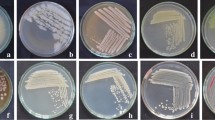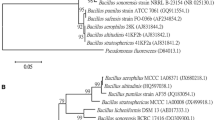Abstract
Investigation of the properties and mechanisms of the interactions of root-colonizing biocontrol bacteria and plant pathogens is necessary to optimize the biocontrol strategies. In the present study, the interaction of a biocontrol strain Bacillus amyloliquefaciens T-5 tagged with a green fluorescent protein marker and a bacterial wilt pathogen Ralstonia solanacearum QL-Rs1115 tagged with red fluorescent protein marker was studied on tomato roots using different inoculation methods. The results showed that in the co-culture experiment, the population of pathogen QL-RFP was decreased by increasing the initial inoculum concentration of biocontrol strain. In the greenhouse experiment, both strains T-5-GFP and QL-RFP colonized tomato roots (root tips, root hairs, primary roots, and root junctions) and formed a biofilm on the root surfaces as determined by dilution plating and confocal laser scanning microscopy (CLSM) techniques. However, the root colonization of pathogen strain QL-RFP was almost completely suppressed in the presence of biocontrol strain T-5-GFP when both soil and plant seedlings were treated with T-5-GFP. The results of this study revealed the effectiveness of strain B. amyloliquefaciens T-5 as a biocontrol agent against tomato wilt pathogen and the significance of inoculation method used to inoculate biocontrol strain.






Similar content being viewed by others
References
Al-Waili N, Salom K, Al-Ghamdi A, Ansari MJ (2012) Antibiotic, pesticide, and microbial contaminants of honey: human health hazards. Scie World J 2012:930849
Aliye N, Fininsa C, Hiskias Y (2008) Evaluation of rhizosphere bacterial antagonists for their potential to bioprotect potato (Solanum tuberosum) against bacterial wilt (Ralstonia solanacearum). Biol Control 47:282–288
Bais HP, Fall R, Vivanco JM (2004) Biocontrol of Bacillus subtilis against infection of Arabidopsis roots by Pseudomonas syringae is facilitated by biofilm formation and surfactin production. Plant Physiol 134:307–319
Bhattacharyya PN, Jha DK (2012) Plant growth-promoting rhizobacteria (PGPR): emergence in agriculture. World J Microbiol Biotechnol 28:1327–1350
Cao Y, Zhang Z, Ling N, Yuan Y, Zheng X, Shen B, Shen Q (2011) Bacillus subtilis SQR 9 can control Fusarium wilt in cucumber by colonizing plant roots. Biol Fert Soils 47:495–506
Compant S, Clément C, Sessitsch A (2010) Plant growth-promoting bacteria in the rhizo- and endosphere of plants: their role, colonization, mechanisms involved and prospects for utilization. Soil Biol Biochem 42:669–678
Czajkowski R, de Boer W, van Veen J, van der Wolf J (2012) Studies on the interaction between the biocontrol agent, Serratia plymuthica A30, and blackleg-causing Dickeya sp. (biovar 3) in potato (Solanum tuberosum). Plant Pathol 61:677–688
D’Alvise PW, Magdenoska O, Melchiorsen J, Nielsen KF, Gram L (2014) Biofilm formation and antibiotic production in Ruegeria mobilis are influenced by intracellular concentrations of cyclic dimeric guanosinmonophosphate. Environ Microbiol 16:1252–1266
Elphinstone J, Hennessy J, Wilson J, Stead D (1996) Sensitivity of different methods for the detection of Ralstonia solanacearum in potato tuber extracts. EPPO Bull 26:663–678
Errampalli D, Leung K, Cassidy M, Kostrzynska M, Blears M, Lee H, Trevors J (1999) Applications of the green fluorescent protein as a molecular marker in environmental microorganisms. J Microbiol Meth 35:187–199
Falk P, Borén T, Haslam D, Caparon M (1995) Bacterial adhesion and colonization assays. Method Cell Biol 45:165–192
Fan B, Chen XH, Budiharjo A, Bleiss W, Vater J, Borriss R (2011) Efficient colonization of plant roots by the plant growth promoting bacterium Bacillus amyloliquefaciens FZB42, engineered to express green fluorescent protein. J Biotechnol 151:303–311
Goedhart J, Van Weeren L, Hink MA, Vischer NO, Jalink K, Gadella TW (2010) Bright cyan fluorescent protein variants identified by fluorescence lifetime screening. Nat Methods 7:137–139
Hayward AC (1991) Biology and epidemiology of bacterial wilt caused by Pseudomonas solanacearum. Annu Rev Phytopathol 29:65–87
Heim R, Tsien RY (1996) Engineering green fluorescent protein for improved brightness, longer wavelengths and fluorescence resonance energy transfer. Curr Biol 6:178–182
Huang Q, Yan X, Wang JF (2012) Improved biovar test for Ralstonia solanacearum. J Microbiol Meth 88:271–274
Janse JD (1996) Potato brown rot in western Europe. History, present occurrence and some remarks on possible origin, epidemiology and control strategies. Bull OEPP 26:679–695
Kamilova F, Validov S, Azarova T, Mulders I, Lugtenberg B (2005) Enrichment for enhanced competitive plant root tip colonizers selects for a new class of biocontrol bacteria. Environ Microbiol 7:1809–1817
Kato A, Miyake T, Nishigata K, Tateishi H, Teraoka T, Arie T (2012) Use of fluorescent proteins to visualize interactions between the Bakanae disease pathogen Gibberella fujikuroi and the biocontrol agent Talaromyces sp. KNB-422. J Gen Plant Pathol 78:54–61
Kempe J, Sequeira L (1983) Biological control of bacterial wilt of potatoes: attempts to induce resistance by treating tubers with bacteria. Plant Dis 67:499–503
Kurabachew H, Stahl F, Wydra K (2013) Global gene expression of rhizobacteria-silicon mediated induced systemic resistance in tomato (Solanum lycopersicum) against Ralstonia solanacearum. Physiol Mol Plant P 84:44–52
Ling N, Zhang W, Tan S, Huang Q, Shen Q (2012) Effect of the nursery application of bioorganic fertilizer on spatial distribution of Fusarium oxysporum f. sp. niveum and its antagonistic bacterium in the rhizosphere of watermelon. Appl Soil Ecol 59:13–19
Masunaka A, Nakaho K, Sakai M, Takahashi H, Takenaka S (2009) Visualization of Ralstonia solanacearum cells during biocontrol of bacterial wilt disease in tomato with Pythium oligandrum. J Gen Plant Pathol 75:281–287
Nihorimbere V, Cawoy H, Seyer A, Brunelle A, Thonart P, Ongena M (2012) Impact of rhizosphere factors on cyclic lipopeptide signature from the plant beneficial strain Bacillus amyloliquefaciens S499. FEMS Microbiol Ecol 79:176–191
Njoloma J, Tanaka K, Shimizu T, Nishiguchi T, Zakria M, Akashi R, Oota M, Akao S (2006) Infection and colonization of aseptically micropropagated sugarcane seedlings by nitrogen-fixing endophytic bacterium, Herbaspirillum sp. B501gfp1. Biol Fert Soils 43:137–143
Oliveira PH, Prather KJ, Prazeres DM, Monteiro GA (2009) Structural instability of plasmid biopharmaceuticals: challenges and implications. Trends Biotechnol 27:503–511
Palaniyandi SA, Yang SH, Zhang L, Suh J-W (2013) Effects of actinobacteria on plant disease suppression and growth promotion. Appl Microbiol Biotechnol 97:9621–9636
Qiu M, Li S, Zhou X, Cui X, Vivanco JM, Zhang N, Shen Q, Zhang R (2014) De-coupling of root-microbiome associations followed by antagonist inoculation improves rhizosphere soil suppressiveness. Biol Fert Soils 50:217–224
Ramesh R, Phadke GS (2012) Rhizosphere and endophytic bacteria for the suppression of eggplant wilt caused by Ralstonia solanacearum. Crop Prot 37:35–41
Raza W, Faheem M, Yousaf S, Rajer FU, Yameen M (2013) Volatile and non-volatile antifungal compounds produced by Trichoderma harzianum SQR-T037 suppressed the growth of Fusarium oxysporum f. sp. niveum. Sci Lett 1:21–24
Ren X, Zhang N, Cao M, Wu K, Shen Q, Huang Q (2012) Biological control of tobacco black shank and colonization of tobacco roots by a Paenibacillus polymyxa strain C5. Biol Fert Soils 48:613–620
Rochat L, Péchy-Tarr M, Baehler E, Maurhofer M, Keel C (2010) Combination of fluorescent reporters for simultaneous monitoring of root colonization and antifungal gene expression by a biocontrol Pseudomonad on cereals with flow cytometry. Mol Plant Microbe In 23:949–961
Sambrook J, Russell DW (2001) Molecular cloning: a laboratory manual, 3rd edn. Cold Spring Harbor Laboratory Press, Cold Spring Harbor, NY
Schoina C, Stringlis IA, Pantelides IS, Tjamos SE, Paplomatas EJ (2011) Evaluation of application methods and biocontrol efficacy of Paenibacillus alvei strain K-165, against the cotton black root rot pathogen Thielaviopsis basicola. Biol Control 58:68–73
Swanson JK, Yao J, Tans-Kersten J, Allen C (2005) Behavior of Ralstonia solanacearum race 3 biovar 2 during latent and active infection of geranium. Phytopathol 95:136–143
Takenaka S, Sekiguchi H, Nakaho K, Tojo M, Masunaka A, Takahashi H (2008) Colonization of Pythium oligandrum in the tomato rhizosphere for biological control of bacterial wilt disease analyzed by real-time PCR and confocal laser-scanning microscopy. Phytopathol 98:187–195
Tan S, Dong Y, Liao H, Huang J, Song S, Xu Y, Shen Q (2013a) Antagonistic bacterium Bacillus amyloliquefaciens induces resistance and controls the bacterial wilt of tomato. Pest Manag Sci 69:1245–1252
Tan S, Jiang Y, Song S, Huang J, Ling N, Xu Y, Shen Q (2013b) Two Bacillus amyloliquefaciens strains isolated using the competitive tomato root enrichment method and their effects on suppressing Ralstonia solanacearum and promoting tomato plant growth. Crop Prot 43:134–140
Tans-Kersten J, Brown D, Allen C (2004) Swimming motility, a virulence trait of Ralstonia solanacearum, is regulated by FlhDC and the plant host environment. Mol Plant Microbe In 17:686–695
Timmusk S, Grantcharova N, Wagner EG (2005) Paenibacillus polymyxa invades plant roots and forms biofilms. Appl Environ Microbiol 71:7292–7300
Torres AR, Araújo WL, Cursino L, de Barros RP, Mondin M, Hungria M, Azevedo JL (2013) Colonization of Madagascar periwinkle (Catharanthus roseus), by endophytes encoding gfp marker. Arch Microbiol 195:483–489
Turner J, Backman P (1991) Factors relating to peanut yield increases after seed treatment with Bacillus subtilis. Plant Dis 75:347–353
Underwood W, Koh S, Somerville SC (2011) Visualizing cellular dynamics in plant-microbe interactions using fluorescent-tagged proteins. Methods Mol Biol 712:283–291
Unge A, Tombolini R, Mølbak L, Jansson JK (1999) Simultaneous monitoring of cell number and metabolic activity of specific bacterial populations with a dual gfp-luxAB marker system. Appl Environ Microb 65:813–821
Vasse J, Frey P, Trigalet A (1995) Microscopic studies of intercellular infection and protoxylem invasion of tomato roots by Pseudomonas solanacearum. Mol Plant Microbe In 8:241–251
Wang P, Zhong Z, Zhou J, Cai T, Zhu J (2008) Exopolysaccharide biosynthesis is important for Mesorhizobium tianshanense: plant host interaction. Arch Microbiol 189:525–530
Wei Z, Yang X, Yin S, Shen Q, Ran W, Xu Y (2011) Efficacy of Bacillus-fortified organic fertiliser in controlling bacterial wilt of tomato in the field. Appl Soil Ecol 48:152–159
Xue Q, Chen Y, Li S, Chen L, Ding G, Guo D, Guo J (2009) Evaluation of the strains of Acinetobacter and Enterobacter as potential biocontrol agents against Ralstonia wilt of tomato. Biol Control 48:252–258
Yu X, Ai C, Xin L, Zhou G (2011) The siderophore-producing bacterium, Bacillus subtilis CAS15, has a biocontrol effect on Fusarium wilt and promotes the growth of pepper. Eur J Soil Biol 47:138–145
Zhang N, Wu K, He X, Li S, Zhang Z, Shen B, Yang X, Zhang R, Huang Q, Shen Q (2011) A new bioorganic fertilizer can effectively control banana wilt by strong colonization with Bacillus subtilis N11. Plant Soil 344:87–97
Acknowledgments
This research was financially supported by the National Natural Science Foundation of China (41301262), the Innovative Research Team Development Plan of the Ministry of Education of China (IRT1256), the Priority Academic Program Development (PAPD) of Jiangsu Higher Education Institutions, and the 111 project (B12009). We would like to acknowledge Prof. Paolo Nannipieri from University of Florence, Italy, for his careful revisions of the manuscript.
Author information
Authors and Affiliations
Corresponding author
Rights and permissions
About this article
Cite this article
Tan, S., Gu, Y., Yang, C. et al. Bacillus amyloliquefaciens T-5 may prevent Ralstonia solanacearum infection through competitive exclusion. Biol Fertil Soils 52, 341–351 (2016). https://doi.org/10.1007/s00374-015-1079-z
Received:
Revised:
Accepted:
Published:
Issue Date:
DOI: https://doi.org/10.1007/s00374-015-1079-z




